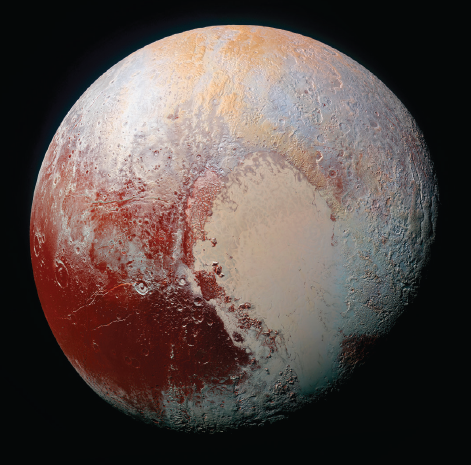And even though the science collection lasted just months, the New Horizons mission had been decades in the making. NASA chose the mission in 2001, the spacecraft launched in 2006, and it reached Pluto on July 14, 2015.
Seeing the pixelated blobs of Pluto and its largest moon, Charon, evolve into complex worlds through the eye of New Horizons was rewarding, satisfying, and awesome, says Stern. That’s because everything about Pluto surprised scientists. They expected a frozen, cratered, and long-dead world with an equally old-looking system of moons. Instead, Pluto’s surface is young, with smooth frozen plains, icy mountains as high as the U.S. Rockies, topography that resemble dunes, a glacial lake, and ice that has recently flowed around other features in the same way that glaciers move on Earth’s surface. The scientists estimate that the uncratered swaths of terrain are 100 million years old, while other regions are billions of years in age.
Pluto’s varied surface with such youthful areas means that something internal must be warming it to make it pliable. And while all the objects in our planetary system would have been warm shortly after the solar system formed 4.5 billion years ago, scientists didn’t think such a small object could stay warm all these years. “We expect small planets to typically run out of energy a lot sooner than the big planets. It’s like a small cup of coffee cools off faster than a bucket of coffee,” says Stern. But what New Horizons has revealed about Pluto, he adds, changes the expectations of planetary geology.
Scientists have also created a map of methane ice distribution, and this material seems to prefer a region of young terrain that scientists have informally named “Sputnik Planum.” Outside of this area, methane is still present and congregates on crater rims and brighter regions but avoids crater centers and darker regions for unknown reasons.
The up-close photos of Pluto have also let scientists precisely measure the width of the dwarf planet: 1,473 miles (2,370km). This secures Pluto as the largest known object orbiting beyond Neptune.
After New Horizons flew by Pluto, it looked back and watched the dwarf planet eclipse the Sun. This alignment let scientists study Pluto’s atmosphere as sunlight filtered through it. Above the surface lie distinct haze layers that extend to about 80 miles (130km) out, several times farther than researchers expected. And New Horizons detected wisps of a nitrogen-rich atmosphere 1,000 miles (1,600km) out.
While Pluto has been the main focus, Charon also has shown surprises. It too has a varied surface, with some regions void of impact craters. Cliffs stretch hundreds of miles across the surface, indicating the crust has fractured. A deep canyon, 4 to 6 miles (6 to 10 km) deep, also scours Charon’s surface.
New Horizons snapped photos of Pluto’s four smaller moons as well: Nix, Hydra, Styx, and Kerberos. While Charon is 751 miles (1,208 km) across, each of these four is just a few dozen miles wide.
Most of New Horizons’ data is still on board the spacecraft and will be downloaded piece by piece over the next several months. Researchers will pore over the additional data in the next few years, learning more every day about Pluto and its moons. Even though humans saved this dwarf system for last in our exploration of the solar system, just the first views exceeded and upended expectations and have given researchers a treasure-trove of new science.










